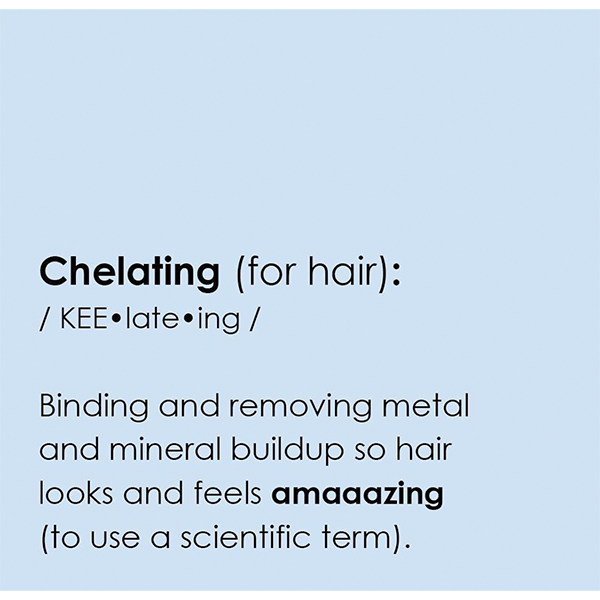Clarifying Vs. Chelating: What You Need To Know
3 Differences Between Clarifying & Chelating
We’ve been seeing chelating treatments popping up EVERYWHERE, including the OLAPLEX Broad Spectrum Chelating Treatment. While we’re all about the promise of hair that looks and feels amazing, how does this treatment work—and how is it different than the clarifying treatments we’ve been using? Keep scrolling to find out.
Clarifying vs. chelating: What’s the difference?
Think of it this way: While clarifying shampoos optimize the results of your hair repair routine, chelating is a PRO-ONLY treatment that elevates the efficiency and final results of all salon services. Here are some of the benefits:
- Removal of discoloring minerals and buildup
- More consistent lightening in less time
- Better penetration of lightener and color
- No mixing or heat required
So, when should you clarify vs. chelate your client’s hair? We’re breaking down the specifics below, so keep reading.
Celeb colorist Chad Kenyon (@chadkenyon) introduces his clients to chelating!

1. OLAPLEX Broad Spectrum Chelating Treatment takes clarifying treatments to the next level.
Chelating treatments are designed to remove cortex-deep deposits, which can hinder your client’s color goals and the effectiveness of color, lightener and other services. Chelation works to rebuild hair simultaneously while gently removing up to 98 percent of impurities and buildup after just one use.
Here’s how it’s done:
- Cleanse the hair with OLAPLEX No.4C Clarifying Shampoo for a clean canvas. Rinse thoroughly.
- Apply Broad Spectrum Chelating Treatment in sections to fully saturate the hair. Leave on for 15 to 30 minutes, depending on the hair texture and amount of buildup.
- Shampoo with OLAPLEX No.4 Bond Maintenance® Shampoo.
- Condition with OLAPLEX 4-IN-1 Moisture Mask.
- Voila—you have the perfect canvas to continue with your salon services!
OLAPLEX artist Carlos Rojas (@colorbycarlos) teaches us how to pronounce “chelating!” 😂
View this post on Instagram
Want to try it for yourself! Click here to try chelating.
2. Clarifying shampoo actually preps the hair for chelation.
So, does chelating replace clarifying? Short answer: No. Deep cleansing clarifying shampoos provide a clean canvas for chelation, while chelating is a PRO ONLY treatment that goes a step further for cortex-deep purification.
Chelating is celeb stylist Tracey Cunningham (@traceycunningham1)‘s new favorite step. “When my client comes back in with {a} dull blonde I know was poppin’ the last time she left my chair, I KNOW she has bad metal or mineral buildup,” she says.
Tell your clients: “There’s nothing wrong with seeing your colorist in between appointments for a little maintenance or using OLAPLEX No.4C at home—and yes it’s sulphate free,” says Tracey.
Watch Tracey apply OLAPLEX’s chelating treatment. Apply to damp hair after shampooing with No.4c for optimal results!
View this post on Instagram
3. Chelating is more of a “prescription” treatment.
Clarifying shampoos can be used on a weekly basis for a thorough cleanse with a fresh, airy result. Chelating, however, is best for clients with moderate to severe build-up. We’re talking enough build-up to compromise their lightening or color results.
Interested in bringing OLAPLEX’s chelating treatment to your salon? Click here.
Products Used
More from
Olaplex
-
Hair Color
The Bubble Technique: 5 Tips To Create Rainbow Hair Color
-
Celebrity
The Best Beauty Looks At The 2024 Oscars
-
Celebrity
12 Questions With Celebrity Colorist, Jenna Perry
-
Haircare
3 Pre-Appointment Steps To Prepare Your Client For A Chemical Service
-
Blonde
The Biggest Hair Color Trends of 2024
-
Industry Events
OLAPLEX Announces New Brand Ambassadors
-
Monthly Product Launch List
New Year, New Hair Launches—See The Best Ones So Far!
-
Awards Shows
Simona Tabasco’s Hollywood-Inspired Glam Waves
-
Awards Shows
The Best Hair & Beauty At The 2024 Emmy Awards
-
Awards Shows
The Best Celebrity Hair Colors & Formulas From The 2024 Golden Globes
-
Curls
Curly Styling: How To Get Defined Curls With One Product
-
Leave-In
No.9 Bond Protector Nourishing Hair Serum
-
Gifts
10 Hair Gift Sets Sure To Spread Joy This Holiday Season
-
BTC Hair Trend Report
Your Guide To Fall & Winter 2023’s Hair Color Trends
-
Blowouts
Use This Trick To Keep Velcro Rollers Sanitary In The Salon
-
Manufacturer
Meet OLADUPÉ: OLAPLEX Dupes Their Own Product in Viral Campaign
-
These September Hair Launches Will Cure Your Post-Summer Blues
-
Conditioners
BLONDE ENHANCER TONING CONDITIONER
-
Facebook Lives
3 Tips For Achieving Waves (Without An Iron!)
-
News
The Hottest Hair Product Launches Of Summer 2023
-
Blowouts
Hailey Bieber’s Hairstylist Shares The Products He Won’t Style Without
-
Haircare
Volumizing Blow Dry Mist
-
Blonde
6 Blonding Techniques To Save Your Client’s Hair
-
BTC Hair Trend Report
Met Gala 2023: The Hottest Hair & Beauty Looks








